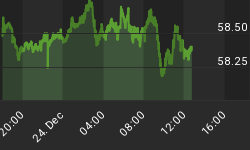As Wall Street continues to put their faith in the "goldilocks" hypothesis, it may come as a surprise to those familiar with my more negative view that I too fully expect this scenario to unfold. However I have a much different and technically far more accurate interpretation of the parable. After eating a bowl of porridge which was neither too hot nor too cold, the little clueless blonde is ultimately chased out of the house by three angry bears. Wall Street bulls will be similarly dispatched. However, upon further reflection I believe that the "Goldilocks" scenario is apt in a way that none of its adherents realize. Wall Street might actually have it half right for a change. In this case it's the first half, "gold."
Thus far in 2007, as all eyes have been fixed on oil's sharp decline, few have noticed the resilience of gold. Since January 1, while oil is off by about 13% and the Dollar Index is up close to 2%, the price of gold has held steady. In fact the gold market has sold off several times in recent months, but held the line at $600 on each occasion. But while gold itself has shown strength, gold mining stocks are off about 7% thus far this year, as traders continue to discount a price decline that has yet to materialize.
To me, this action is indicative of some serious physical buying. For now the growing demand is being satisfied by nervous longs exiting the market and speculative shorts betting on a decline. However, a market that refuses to break will eventually turn and head higher. When that happens, a spectacular gold rally will likely ensue. Those who sold prematurely will rush to re-establish their long positions and those who sold short will rush to cover. With few sellers left to take the other side of the trades, the price of gold will spike higher.
On the fundamental side, gold's outlook continues to brighten. Bond prices continue to fall, with the yield on the 10 year now up 40 basis points from its December low. Despite Wall Street's positive spin that rates are rising based on evidence of an improving economy, the gold market indicates something far more troublesome. My hunch is that this bond sell-off will gather momentum, with ten year yields exceeding 5.5% by spring.
A continued rise in yields will dampen the hoped for springtime demand for new homes (typically the busiest home buying season) that many are hoping will help the housing market turn around. Rather than a flood of new buyers, I expect a deluge of sellers. If anyone thinks the supply of unsold homes is high now just wait until the fall. With today's inflated prices, the process of waiting for a qualified homebuyer is becoming the real world equivalent of waiting for Godot.
As if higher interest rates weren't bad enough, the recent re-emergence of traditional mortgage lending standards indicates that a return to traditional real estate prices may not be too far off. Of course that is a huge problem as traditional prices, which are underpinned by incomes, the ability to offer down-payments, or rental returns, are far below current levels.
During the recent real estate mania lenders assumed that down payments, fully amortized loans, documentation of income, and various ratios that traditionally measure affordability, no longer applied. Lenders became convinced that this was a new era where their sophistication and skill at assessing and managing risk meant that virtually anyone could borrow any amount. The reality of course was that it was not smart lenders, but a speculative bubble that saved the day. As home prices kept rising borrowers could re-finance or sell their way out of any problem. However, as real estate prices fall and homes become harder to sell, defaults are on the rise.
In a misguided attempt to prop up the housing market, the Fed will reluctantly cut interested rates. However, this will actually have the opposite effect on the housing market. The dollar will plunge sending long-term interest rates higher, exacerbating the recession, and making housing even less affordable. In the end Bernanke will feel he has no choice other than to rev up his helicopter engines. The recent strength in gold suggests that those engines might already be warming up.
Don't wait for reality to set in. Protect your wealth and preserve your purchasing power before it's too late. Discover the best way to buy gold at www.goldyoucanfold.com, download my free research report on the powerful case for investing in foreign equities available at www.researchreportone.com, and subscribe to my free, on-line investment newsletter at http://www.europac.net/newsletter/newsletter.asp.
















